Site Menu:
| This is an archived Horseadvice.com Discussion. The parent article and menus are available on the navigation menu below: |
| HorseAdvice.com » Diseases of Horses » Lameness » Diseases of the Spine, Back & Pelvis » Lower Back Pain in Horses » |
| Discussion on Kissing spine | |
| Author | Message |
| New Member: txgf |
Posted on Thursday, Aug 13, 2009 - 8:34 pm: Dr. O and others,I have a horse that has been tentatively diagnosed with spinous process impingement/kissing spine and could use some feedback on how to proceed. The horse is a 3 yr. old, 16.3 hand QH/TB gelding. I sent him off for some basic under saddle training in May to get him started. Where, he did fine and progressed well except that I noticed 3 weeks into work that he appeared very "sloppy". The quality of his movement had really digressed (hollow backed and not driving with his hind end). Under saddle, he never exhibited unwillingness to work. A week later I pulled him from training because he had begun interfering in the hind enough to create small sores on his fetlocks and his poor movement was simply out of character. Once home, I had my vet examine him for the interfering, overall body soreness, and fairly repetitive shifting of his hind legs. I was directed to give the horse a few weeks rest, hyDrOtherapy, leg wrapping. Prophylactically, Adequan injections were given, added Cosequin ASU, and I opted to also try some accupuncture (by a licensed vet certified in it). 4 weeks into this, I would say we could see an 85% improvement in his tracking by watching him move in a 60 foot round pen. Last week was week 5, and when I evaluated him, he appeared to not be tracking or driving with his hind end as well. My regular vet was out of town, so I made an appointment with one of the nearby lameness specialist. A fairly thorough exam was done, and no lameness was exhibited. We discussed at length the things I was seeing. Spinal radiographs were recommended and taken. Based on the xrays, a diagnosis of kissing spines was reached. Needless to say, I'm a little floored and not real sure how to proceed. For now, I am trying to gather information so I can make informed decisions. After consulting with the vet, I consented to having steroid injections done to the back. I was told to monitor for improvement and report how things go. Potential surgical approach was discussed. This horse, is one quite dear to my heart...and I'm willing to go the extra mile for him, but also need to be realistic in regards to expectations. In the interest of not jumping the gun, I will probably pursue a 2nd opinion/evaluation for good measure. I tried to upload the digital xrays for you to see, but it gives me an error message. Any information or thoughts you have would be greatly appreciated. Heather |
| New Member: txgf |
Posted on Thursday, Aug 13, 2009 - 8:48 pm: Ok, giving it a try another way. If this doesn't work well, let me know.Thank you again. https://i49.photobucket.com/albums/f298/HeatherCK11/Other/buddykutyba0001.jpg https://i49.photobucket.com/albums/f298/HeatherCK11/Other/buddykutyba0002.jpg https://i49.photobucket.com/albums/f298/HeatherCK11/Other/buddykutyba0003.jpg https://i49.photobucket.com/albums/f298/HeatherCK11/Other/buddykutyba0004.jpg |
| Moderator: DrO |
Posted on Friday, Aug 14, 2009 - 3:07 am: Hello TXGF,Did you read the article on lower back pain? In post mortem surveys of horses without history of backpain, 100% have one or more vertebral spinous process impingement or what is commonly called kissing spines. Put another way almost all horses have VSPI so there is no need to be devastated. If you get no response from treatment the article discusses better ways to rule in or rule out if this condition is actually causing pain. I would note that a three year old described this way when first faced with life under a saddle is not that odd as it takes time to build strength and coordination to deal with the changes of having a rider on your back. If medical causes remain speculative consider continuing what you are doing already: back up a bit and find training exercises your horse enjoys doing and then continue forward more slowly. If lazy hind end problems persist and no cause of pain is found I would recommend a good neurological exam. DrO |
| Member: txgf |
Posted on Friday, Aug 14, 2009 - 10:00 pm: Dr. OThank you for the response. Yes, I did read the article..and have since gone back and reviewed it again. I appreciate your "voice of reason" and reinforcing that while radiographically we may see something it does not always dictate #1 to symptoms, nor #2 prognosis. Always good to remember. The results of my horses xrays were somewhat presented to me as the smoking gun along with a questionable prognosis. The vet certainly did not state that surgical intervention was the only way to go...but it was discussed in detail. With my head back on straight (and more information in hand) I feel confident with your advice and approach. On Monday, I will talk with my regular veterinarian as well. For now, starting him back under saddle with a slow conditioning program will be my goal. Continue the Cosequin and weekly accupuncture. Lots of slow work with stretching and encouraging use of the back and hind end. I watched him move today (3 days post injection), and he does appear more fluid and tracking up symetrically with the hind legs. Is this because of his back, I don't know since the injections are intramuscular they can affect him systemically vs. locally. One step at a time. If we don't have success or he declines I will pursue additional ortho & neuro consults/diagnostics. Once again, thanks for pulling me off the ledge and feel free to input any recomendations you may have  . . Heather |
| Member: txgf |
Posted on Friday, Apr 30, 2010 - 1:29 am: Dr. O,I posted last year regarding this horse and wanted to give an update and get your thoughts. After several months, lots of strength training, and a few vet visits, improvement with my horse was not noteworthy. Initially after the back injections, he did do better but displayed difficulty at the canter. He was given some time off and brought back slowly. That did not seem to help. Transitions from trot to canter sloppy, unable to collect & hold the canter, and overall resistance. Several explosive bucking episodes while lunging. The vets requested I do a trial of bute daily and monitor for improvement. Positive progress was noted. At no time was "lameness" noted Considering the information/research on kissing spine I was at a loss as to how to proceed. While we knew he was in discomfort, we could not pinpoint exactly why or where. Earlier this week he was taken to the university for a full workup. This included: 1. lameness evaluation in hand, on the line, and under saddle. Gait analysis & flexion tests. 2. neuro exam 3. bloodwork Once again, he was the soundest not-right horse. After his riding exam (with me), one of the vets got on him. This pretty much changed everything. She agreed whole heartedly that his canter was very 'wrong'. All tests were repeated & they palpated him head to toe. He was then scheduled for neck xrays & scintigraphy. Notes: No lameness apparent. No response to flexion of the front or hind limbs. Lunging: no lameness apparent. Occasionally missed his hind lead while cantering to the left. Riding: No lameness was apparent under saddle. Consistent resistance cantering either direction by throwing his head and slinging his body. He occasionally appeared hypermetric in the forelimbs when making the transition from trot to canter. Walking in hand: circled normally both directions. Several mistakes with his rt. forelimb while negotiating the curb. Backed normally. Mildly hypermetric in both forelimbs when walking with his head elevated. The following are the results: Bloodwork: All values collected serially before/during exercise WNL. Cervical spine xrays: mild changes in the dorsal facets of he C6-C7 cervical articulation. Nucl Scintigraphy: (full body) Spine: Mild increased uptake in the C6-C7 region of the cervical spine. No increased uptake in any of the vertebrae in the back. No abnormalities in the forelimbs, hindlimbs, or pelvis. Diagnosis: Possible caudal Cervical Inflammation Treatment: Cervical facets of the C6-C7 region of the cervical spine were injected (depo, hylartinV, amikacin) Instructions are that he to be rested for a week/no forced exercise/turn out ok. After that, I'm to begin light lunging & riding. No cantering under saddle until he is rechecked (4 weeks approx). So, here we are. Feel like I've done all I can to attempt to find the source of his discomfort. During discussion with the vets, a lot of this may be a wait and see how he responds. I did get full copies of his rads & bone scan. These have been sent off to an external specialist for consultation. Figure it can't hurt. This is a very kind horse. Through all of this, he has tried over and over to do what I asked of him. There is a big discrepancy in his size & my lack thereof. It would take nothing for him to disregard any request...yet he wouldn't consider it. I'm not even sure of what questions to ask you. By the above information would you care to respond or provide any words of wisdom? TIA, Heather |
| Member: cometrdr |
Posted on Friday, Apr 30, 2010 - 6:26 pm: I would totally let the vets and more experienced persons weigh in here - but IMO - maybe cause he's young, and the training seems (or seemed) strenous - perhaps he is bored or had enough? or is not suited to the discipline?he sounds like a nice horse - how bout relaxing him for a few months and trying just trail on him for a few years till he grows in to his body? creates muscled along his top line to support you? I could be way off but would feel wrong if I did not express those 2 cent bits... |
| Member: txgf |
Posted on Friday, Apr 30, 2010 - 11:34 pm: Hi Muffi,Thank you for contributing. I probably should have been more clear in regards to his training. This is still a green horse. He is not in active show/work training. That goal was set aside last year after I pulled him from initial under saddle work 4 weeks into training. I did find out later that my horse was involved in a flipping incident. All riding efforts have been focused on getting the w-t-c down, leg yielding, transitions, etc. I pursued an ortho consult in Aug '09 because him movement was uncharacteristically poor at the canter. The KS diagnosis made and back injections done at that time. I was instructed to work him and monitor for progress. He did improve, trot had a lot of suspension and extension...canter cleaned up a little. We focused on strength building by lots of walking & long trotting in the pasture. In the interest of giving him time to find himself, I gave him off November - March. Just recently started him back the first week of April. His canter (esp to the rt) is profoundly unstable if not unsafe, to the point it feels like he is going to fall. He is also visibly like this when longing. This is a good horse. He's a good guy. When he struggles, it's not a resistant "I'm not going to do it", it's a physical thing. He compensates with his whole body at the canter almost working in an inverted frame...but still will do it if I ask him. The university vets do believe this is a pain oriented problem vs. behavioral one. Question being, where do we do from here? Can't very well expect a painful animal to be successful in training nor reliable as a mount. |
| Member: dsibley |
Posted on Saturday, May 1, 2010 - 7:25 am: How I feel your pain! Look up my old thread: Horse falls under saddle...OUCH! That details some of my experience with Baron. His final outcome was not good, but I believe he had other issues as well that compounded the KS problem.Although I am not a vet, I can give some lay advice learned through experience. First and foremost, DO NOT trail ride this horse until he is stable. Baron fell on me, and it was not pretty! Management of KS, from what the vets told me, begins with building up the top line and the supporting musculature. Allowing movement with the spine inverted or hyperextended only adds to the issues. Baron's problems became much worse when I moved him to our new place and for the first time he was allowed to run in the pasture. Beautiful animal...head high in the air, his back hollowed out...he went downhill from there. I spent a tremendous amount of time longeing in a surcingle with side reins to keep him in frame, keep the back rounded and get the muscles built up. I started with two minutes...one each direction...and built up very gradually to fifteen minutes each way. No canter, just walk and trot. Another factor that seemed to help was a good farrier. X-rays of the feet determined the exact angle that the trims needed to follow. He was rounded and rolled pretty drastically so that he would reach under himself to the max, further rounding the spine. Again, he had other issues with his feet, so that was why the initial x-rays were done. So, once I figured out that pasture turnout was not good for this guy, and then began to manage the issues, he got better for a period of time. Keep in mind that his KS was pretty bad, and there were behavioral issues as well. A former boarder had a TB with kissing spine. She managed his issues with a heating pad and long, gradual warm-ups, keeping him rounded and collected. That horse had a very successful career as a 3-day eventer. Good luck, and keep us informed as to the progress! |
| Moderator: DrO |
Posted on Saturday, May 1, 2010 - 11:53 am: Hello TXGF,I am so sorry to hear about how your ordeal has played out. I can see waiting and giving the most recent treatment some time to help but after that if this does not succeed you need to ask yourself some questions. 1) Where do you want to go with your riding and horsemanship? 2) Given a poor to guarded prognosis for complete soundness how does this horse figure in to your goals? 3) Given your resources what is in this horse's future? DrO |
| Member: txgf |
Posted on Saturday, May 1, 2010 - 4:27 pm: Dr. O,Your tone speaks volumes and it echo's my gut feeling. The questions you've placed have already been running through my head for a while. This horse was centered to be my national caliber hunt seater. This looks to be a mute point until proven otherwise. I know not to put all my eggs in one basket. However, this is a horse I bred, raised and nurtured. I don't know if this injury/condition became as a result of his "accident" at the trainers, but my suspicion is, it did. He left my barn moving flawlessly, and in short order all that was just gone. For that reason, I feel completely responsible even if it was not by my own hands. "Time", is something I do have. Medically speaking, if he does not respond with the injections, avenues seem limited. This is my interpretation at least. The vets at the university stated he was not a wobbler, and he's not likely an active kissing spine case by the bone scan. The potential "caudal cervical inflammation" leaves me unsure of how to classify the diagnosis. If it's inflammation, is there opportunity for it to resolve? Hypermetric symptoms lead me to believe there is more going on. Good vibes aren't coming my way. I don't know if there is a performance future for this horse. Honestly...don't know what to think at all and am sorry if I am talking around the rose bush. At this time, I'm not prepared to make any rash decisions. My gut tells me he is SOL, despite looking like a healthy animal. Maybe I'm wrong. I'm willing to give this a go, already gone this far  . In the mean time, he will get lots of apples and pats....and I have started working with my other young prospect. Changing gears and focus for myself is a good idea. . In the mean time, he will get lots of apples and pats....and I have started working with my other young prospect. Changing gears and focus for myself is a good idea. His entire radiographic history along with the scintigraphy has been sent to a set of specialists for review. The results of it should be in hand next week. I will be sure to post the summary. I really appreciate your feedback. Heather ps. any chance you could take a peek at his cervical xrays if I could manage to get them posted? |
| Moderator: DrO |
Posted on Sunday, May 2, 2010 - 10:29 am: Yes, it is possible for inflammation to resolve but if there is radiographic evidence it suggests a chronic process that may be managed but not cured. If you will post the radiographs and the complete text of the evaluation I would be glad to review it.DrO |
| Member: txgf |
Posted on Monday, May 3, 2010 - 12:30 am: Dieliz...thank you for the detailed response and your experience with KS. The vets 'think' my horse is non-symptomatic in regards to the KS. The exercise routine you described with your horse is quite similar to the one I used as well. Ok, probably not as patient or slow as you . . Your horse did better overall when confined vs turnout? There will be no trail riding. For now, level ground only. In a few days, I'm supposed to start with slow walking in the saddle. All expectations have been stripped. Hoping for the best, but preparing for the worst until proven otherwise. Thank you again, and will keep ya'll informed. Heather |
| Member: txgf |
Posted on Monday, May 3, 2010 - 1:28 am: Dr. O,Had a little trouble uploading the pics, so I've attached them to photobucket. The radiography notes on the summary state: "Cervical spine"-There were mild changes in the dorsal facets of the C6-C7 cervical articulation. The complete summary is almost 3 pages long, including exam findings. If you'd like to see that, I will try and get it scanned. While hard to read, my initial (recent) post hits the highlights. [IMG]https://i49.photobucket.com/albums/f298/HeatherCK11/Radiographs/cervrad7.jpg[/IMG] [IMG]https://i49.photobucket.com/albums/f298/HeatherCK11/Radiographs/cervrad6.jpg[/IMG] [IMG]https://i49.photobucket.com/albums/f298/HeatherCK11/Radiographs/cervrad5.jpg[/IMG] [IMG]https://i49.photobucket.com/albums/f298/HeatherCK11/Radiographs/cervrad4.jpg[/IMG] [IMG]https://i49.photobucket.com/albums/f298/HeatherCK11/Radiographs/cervrad3.jpg[/IMG] [IMG]https://i49.photobucket.com/albums/f298/HeatherCK11/Radiographs/cervrad2.jpg[/IMG] [IMG]https://i49.photobucket.com/albums/f298/HeatherCK11/Radiographs/cervrad1.jpg[/IMG] Thank you for your time. Heather |
| Member: dsibley |
Posted on Monday, May 3, 2010 - 7:07 am: In looking back over his very long medical history, I believe Baron was always mildly symptomatic until I brought him to my new place and he was turned out in the pasture daily. He was the figurehead of my stable, always running and bucking, beautiful to watch, but always with his head high in the air and his back hollowed out. After that we had several incidents where he fell on me under saddle, then the severe lameness started.It wasn't clear that this is what caused the drastic increase in symptoms, but I truly believe it added to the problems. Once I started keeping him in his run, I put him on a 5-day per week exercise program, even though the run is large enough to get some moderate exercise at will. I also believe that the drastic trim and shoeing helped him a lot as well. We had to keep him on a 4-week farrier schedule, as he would start to get lame again if his toes grew too much. Lots of management but some can lead very useful and pain-free lives, depending on the severity of the condition. Good luck! |
| Moderator: DrO |
Posted on Thursday, May 6, 2010 - 5:58 am: Hello TGXF,The images appear to be removed from photobucket. For help on uploading images see, HorseAdvice.com » Help & Information on Using This Site » Uploading Images and Files Into a Posting. DrO |
| Member: txgf |
Posted on Thursday, May 6, 2010 - 11:34 pm: Sorry about that. Not sure why they aren't viewable.I've tried resizing them to load directly Testing, testing: 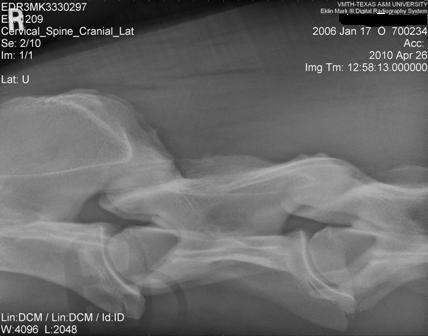
|
| Member: txgf |
Posted on Thursday, May 6, 2010 - 11:43 pm: We have success. On to the next rads: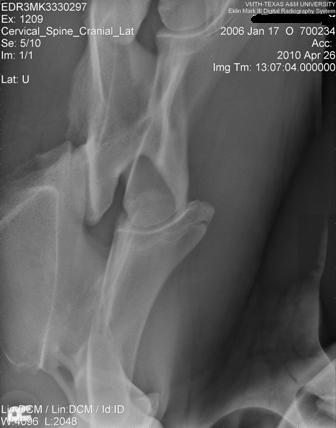 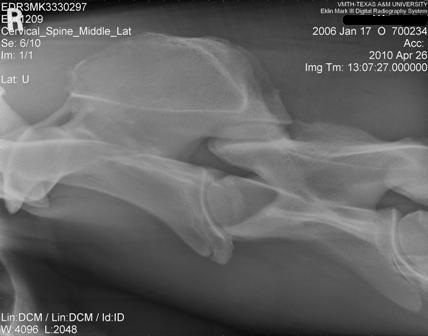 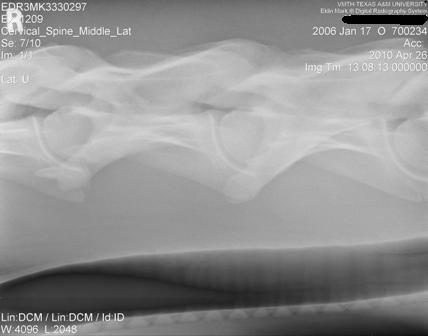 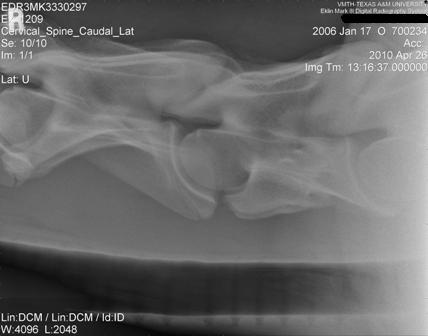 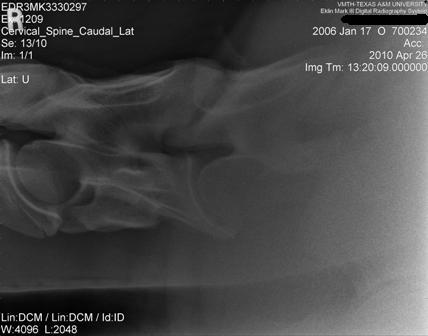 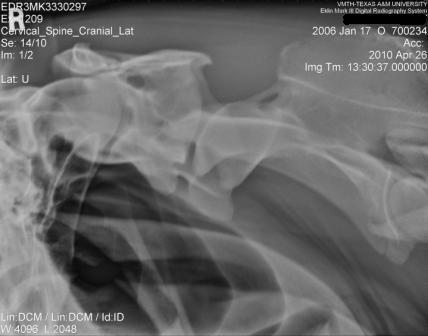
|
| Member: gramsey1 |
Posted on Wednesday, Jan 19, 2011 - 10:11 pm: Dr. O.Was this thread truncated? I am interested in your reading. And the outcome of this case. |
| Moderator: DrO |
Posted on Saturday, Jan 22, 2011 - 9:53 am: Hello Guy,No I don't think it was truncated. Though I am open to interpreting specific lesions, the quality of posted radiographic images and the complexity of these areas, makes a "reading" unrealistic. Reviewing the original diagnosis of a mild C6-C7 dorsal facet arthropathy, there are some irregular margins evident in the images but at the border of the images resolution. I agree with their interpretation there is nothing there diagnostic for the condition TXGF describes. DrO |
| Member: gramsey1 |
Posted on Saturday, Jan 22, 2011 - 12:50 pm: I will start another discussion, Backsore?We are in a similar situation. |
| Member: txgf |
Posted on Saturday, Jan 22, 2011 - 8:40 pm: Guy,sorry to hear you are in the same or similar situation. Do you have any specific questions about this horse/this case? Happy to share if it is helpful in any way.FWIW, I do have some lengthy reviews of the above rads, and many more (for that matter). I had my horses information, history, all radiographs, and bone scan sent off for external review by boarded specialists (orthopedic & radiology). Despite all the literature stats, the consensus is that my horse is affected by the impinging vertebrae. |
| New Member: rhosalin |
Posted on Sunday, Jun 19, 2011 - 8:38 am: Hi Heather~I was searching posts to find help for my situation. I have a 4 year old Hanoverian that will NOT trot or canter..... She is completely in pain... anyway.... I am so sorry to hear about your troubles. I know how stressful and frustrating it is to not know what is going on with our horses. You have spent a long time worrying, hoping, wondering, what-ifs, maybes, could be's, and not to mention a lot of money. I read all your posts on this and I am happy to say you have done everything a GOOD horse owner should have done for this guy. Even though you have not fixed the situation yet, you CAN say that you have done everything. I don't have any idea what miracle drug you could give him to help him... If you find one let me know. :-) I just wanted to let you know that I feel for what you are going through and I do wish you all the best! Hang in there.. |
| Member: babychop |
Posted on Sunday, Jun 19, 2011 - 11:32 am: There was a wonderful speaker at the USDF convention in 2010 on this very subject, can't recall her name at the moment but if you contact USDF they should be able to put you in touch with her. This is her field, she can help explain what to expect and tell you more about it. Her class was part of USDF University. |
is The Horseman's Advisor
Helping Thousands of Equestrians, Farriers, and Veterinarians Every Day
All rights reserved, © 1997 -
